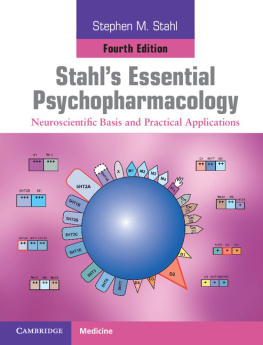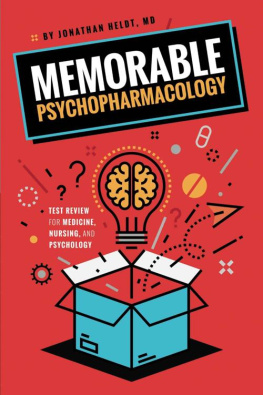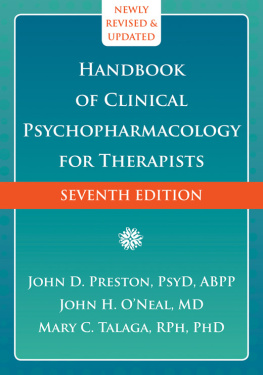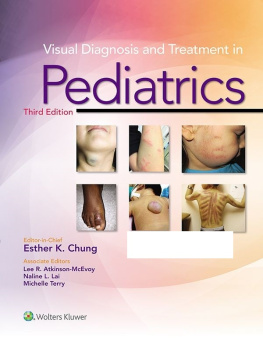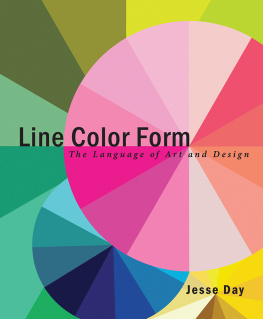Stahls Illustrated
Substance Use and
Impulsive Disorders
Stephen M. Stahl
University of California at San Diego
Meghan M. Grady
Neuroscience Education Institute
Nancy Muntner
Illustrations

CAMBRIDGE UNIVERSITY PRESS
Cambridge, New York, Melbourne, Madrid, Cape Town, Singapore,
So Paulo, Delhi, Dubai
Cambridge University Press
The Edinburgh Building, Cambridge CBZ 8RU, UK
Published in the United States of America by
Cambridge University Press, New York
www.cambridge.org
Information on this title: www.cambridge.org/9781107674530
Neuroscience Education Institute 2012
This publication is in copyright. Subject to statutory exception and to the provisions of relevant collective licensing agreements, no reproduction of any part may take place without the written permission of Cambridge University Press.
First published 2012
Printed and Bound in the United Kingdom by the MPG Books Group
A catalog record for this publication is available from the British Library.
Library of Congress Cataloging in Publication data
ISBN 978-1-107-67453-0 Paperback
Cambridge University Press has no responsibility for the persistence or accuracy of URLs for external or third-party Internet Web sites referred to in this publication and does not guarantee that any content on such Web sites is, or will remain, accurate or appropriate.
Every effort has been made in preparing this book to provide accurate and up-to-date information that is in accord with accepted standards and practice at the time of publication. Although case histories are drawn from actual cases, every effort has been made to disguise the identities of the individuals involved. Nevertheless, the authors, editors, and publishers can make no warranties that the information contained herein is totally free from error, not least because clinical standards are constantly changing through research and regulation. The authors, editors, and publishers therefore disclaim all liability for direct or consequential damages resulting from the use of material contained in this book. Readers are strongly advised to pay careful attention to information provided by the manufacturer of any drugs or equipment that they plan to use.
PREFACE
These books are designed to be fun, with all concepts illustrated by full-color images and the text serving as a supplement to figures, images, and tables. The visual learner will find that this book makes psychopharmacological concepts easy to master, while the non-visual learner may enjoy a shortened text version of complex psychopharmacological concepts. Each chapter builds upon previous chapters, synthesizing information from basic biology and diagnostics to building treatment plans and dealing with complications and comorbidities.
Novices may want to approach this book by first looking through all the graphics, gaining a feel for the visual vocabulary on which our psychopharmacological concepts rely. After this once-over glance, we suggest going back through the book to incorporate the images with supporting text. Learning from visual concepts and textual supplements should reinforce one another, providing you with solid conceptual understanding at each step along the way.
Readers more familiar with these topics should find that going back and forth between images and text provides an interaction with which to vividly conceptualize complex psychopharmacology. You may find yourself using this book frequently to refresh your psychopharmacological knowledge. And you will hopefully refer your colleagues to this desk reference.
This book is intended as a conceptual overview of different topics; we provide you with a visual-based language to incorporate the rules of psychopharmacology at the expense of discussing the exceptions to these rules. The References section at the end gives you a good start for more in-depth learning about particular concepts presented here.
When you come across an abbreviation you dont understand, you can refer to the Abbreviations list in the back. Stahls Essential Psychopharmacology, 3rd Edition, and Stahls Essential Psychopharmacology: The Prescribers Guide, 4th Edition, can be helpful supplementary tools for more in-depth information on particular topics in this book. Now you can also search topics in psychopharmacology on the Neuroscience Education Institutes Web site (www.neiglobal.com) for lectures, courses, slides, and related articles.
Whether you are a novice or an experienced psychopharmacologist, this book will hopefully lead you to think critically about the complexities involved in psychiatric disorders and their treatments.
Best wishes for your educational journey into the fascinating field of psychopharmacology!

Table of Contents
CME Information
Overview
In this book, we provide the biological background that will enable the reader to understand not only how chronic drug exposure is thought to alter reward circuitry, but also how currently available treatments for various substance use disorders work in the brain. We also review screening, treatment, and general management strategies for patients with addiction to various substances of abuse. In addition, we briefly touch on impulse control disorders that may have neurobiological similarities to drug addiction.
Target Audience
This activity has been developed for psychiatrists specializing in psychopharmacology. There are no prerequisites. All other health care providers who are interested in psychopharmacology are welcome for advanced study, especially primary care physicians, nurse practitioners, psychologists, and pharmacists.
Statement of Need
The following unmet needs and professional practice gaps regarding substance use were revealed following a critical analysis of activity feedback, expert faculty assessment, literature review, and through new medical knowledge:
- Substance use disorders (SUDs) are associated with significant medical, psychiatric, social, and economic consequences for both the individual and society
- Individuals who abuse and/or are dependent on substances generally need treatment to remit, making active participation of the clinician integral to the patients successful recovery
- In a 2011 NEI Survey, 40% of respondents indicated a lack of competence in terms of treating alcohol dependence, 26% indicated lack of competence conducting a brief intervention for patients with SUDs, and 35% indicated lack of competence treating patients with SUDs and psychiatric illness
To help address clinician performance gaps with respect to diagnosis and treatment of substance use disorders, quality improvement efforts need to provide education regarding (1) screening methods for substance use disorders and how to implement them for all patients; (2) appropriate advice and management strategies for patients at risk of substance use disorders; (3) current and emerging treatment strategies for various substance use disorders; (4) techniques for monitoring patient progress and addressing adherence concerns; and (5) underlying risk factors for substance use disorders, including clinical, behavioral, and neurobiological factors.
Learning Objectives
After completing this activity, participants should be better able to:
- Apply evidence-based screening methods to identify patients who are dependent or at risk of becoming dependent on substances of abuse
Next page

